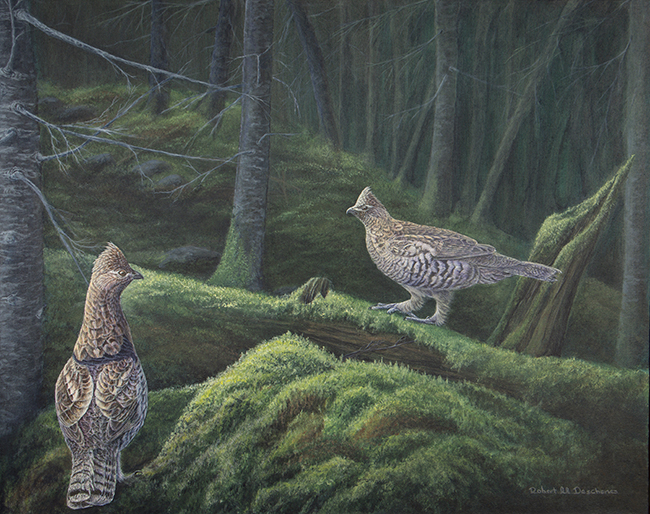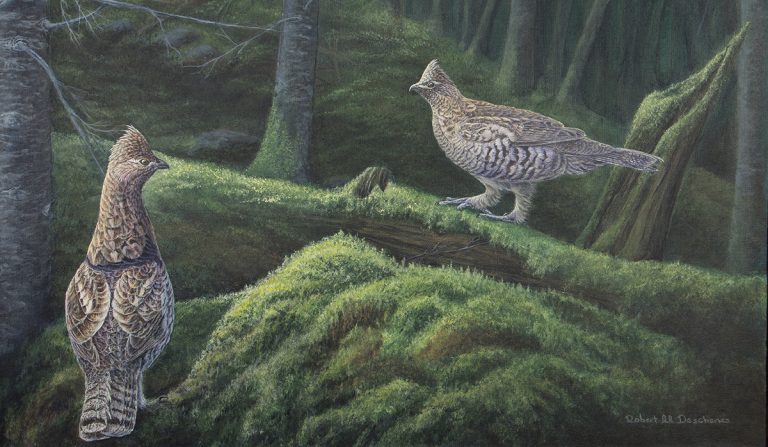Robert M. Deschenes, a Quebec-based naturalist wildlife artist, has carved out a niche in the art world with his hyperrealistic paintings. Using watercolor and acrylic, Deschenes creates lifelike depictions of wildlife and their habitats, reflecting his profound connection with nature. His art serves not only as a visual delight but also as a poignant reminder of the vulnerability of biodiversity and the urgent need for its protection.

Deschenes’ journey into the world of art began in the lush, diverse landscapes of Quebec. Surrounded by the natural beauty of his homeland, he developed an early fascination with wildlife. This fascination blossomed into a passion for capturing the intricate details of animals and their environments on canvas. His early works showcased a keen eye for detail and an ability to render his subjects with striking realism.
Deschenes’ art is driven by a deep respect for nature and a desire to evoke emotion in his viewers. He believes that by creating a connection between the viewer and the subject, he can inspire a greater appreciation for the natural world. His paintings are not just images but experiences that invite viewers to step into the scenes he depicts and feel the presence of the wildlife he so meticulously portrays.
Hyperrealism is a genre of painting and sculpture resembling a high-resolution photograph. Deschenes’ work epitomizes this genre, with every feather, leaf, and light reflection rendered in exquisite detail. His technique allows him to create paintings that are almost indistinguishable from reality, capturing the essence of his subjects with uncanny precision.
One of Deschenes’ works, “Spruce Whispers,” is a testament to his skill and artistic vision. This acrylic on canvas painting, measuring 24 x 30 inches, transports the viewer to an ancient coniferous forest. Amidst a verdant carpet of moss, two majestic Ruffed Grouse stand in quiet elegance. The painting captures the serene beauty and timeless wonder of nature, highlighting the graceful presence of these elusive forest dwellers.
In “Spruce Whispers,” Deschenes’ attention to detail is evident. The texture of the grouse’s feathers, the interplay of light and shadow on the moss, and the subtle variations in the bark of the spruce trees all contribute to the painting’s lifelike quality. The scene is so vividly rendered that one can almost hear the whisper of the wind through the trees and the rustle of leaves underfoot.
Deschenes’ work goes beyond technical excellence. His paintings evoke a sense of tranquility and reverence for the natural world. By capturing moments of quiet beauty and depicting wildlife in their natural habitats, he invites viewers to pause and reflect on the delicate balance of nature. This emotional connection is a crucial aspect of his art, fostering a deeper appreciation for wildlife and the ecosystems that sustain them.
Deschenes’ commitment to wildlife and environmental conservation is evident in his work. His paintings highlight the vulnerability of biodiversity and serve as a call to action for its protection. By bringing the beauty and fragility of nature to the forefront, he hopes to inspire others to become stewards of the environment.
Hyperrealistic art, with its emphasis on detail and accuracy, has a unique power to engage viewers. Deschenes harnesses this power to create awareness about the importance of conservation. His paintings are not just aesthetically pleasing but also educational, offering insights into the behavior and habitats of various wildlife species.
Deschenes’ hyperrealistic paintings continue to captivate audiences, drawing them into the serene and often overlooked corners of nature. As viewers connect with his work, they are reminded of the beauty and fragility of the world around them, and the imperative need to protect it.
Robert M. Deschenes’ hyperrealistic wildlife art is a celebration of nature’s beauty and a powerful tool for conservation. His ability to capture the essence of wildlife in stunning detail creates a lasting impact on those who view his work. As he continues to paint and advocate for the natural world, his art remains a testament to the importance of preserving the delicate balance of our ecosystems.

